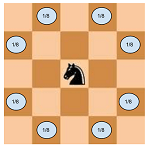Knight on a Chess Board
Given the size of the chess board and initial position of the knight, what is the probability that after k moves the knight will be inside the chess board.
Note:-
1) The knight makes its all 8 possible moves with equal probability.
2) Once the knight is outside the chess board it cannot come back inside.

Puzzlefry added Info-
This challenge is originally from a blog post of crazyforcode.com published under the CC BY-NC-ND 2.5 IN licence.
ALGORITHM:
Start with the initial coordinates of the knight.
Make all possible moves for this position and multiply these moves with their probability, for each move recursively call the function continue this process till the terminating condition is met. Terminating condition is if the knight is outside the chess board, in this case return 0, or the desired number of moves is exhausted, in this case return 1.
As we can see that the current state of the recursion is dependent only on the current coordinates and number of steps done so far. Therefore we can memorize this information in a tabular form.
For better understanding and Computer program of the algo – crazyforcode.com
After removing mirror images, there are six unique positions on the board: (1,1), (1,2), (1,3), (2,2), (2,3), (3,3). The knight starts at (3,3).
From each position, there is a fixed probability of moving to each of the other five positions. The probability of moving off the board is 1 minus the sum of the probabilities of moving to other board positions.
. -------- starting position -------- . (1,1) (1,2) (1,3) (2,2) (2,3) (3,3) (1,1) .250 (1,2) .250 .250 1.000 (1,3) .125 .250 (2,2) .125 .250 (2,3) .250 .250 .250 (3,3) .125
A quick examination reveals that positions (1,3) and (2,2) are equivalent–they each have the same probability for the following square. So we can collapse them into a single state we’ll label as (*,*), giving the following five position table.
. ----- starting position ----- . (1,1) (1,2) (*,*) (2,3) (3,3) (1,1) .250 (1,2) .250 1.000 (*.*) .250 .500 (2,3) .250 .250 (3,3) .125
The probability for the knight to be in each of the five positions at the end of k moves is the sum of the product of probability of the knight moving to that position from another position and the probability of having been in that position at the end of k-1 moves. At zero moves, the probability of being in position (3,3) is 1 and the probability of being elsewhere on the board is 0. After each move, the probability of the knight having moved off the board is 1 minus the sum of the probabilities of it being in each position.
k (1,1) (1,2) (*,*) (2,3) (3,3) Off board 0 1.00000 1 1.00000 2 0.25000 0.12500 0.62500 3 0.18750 0.06250 0.75000 4 0.01563 0.07813 0.02344 0.88281 5 0.04297 0.02344 0.93359 6 0.00586 0.02246 0.00537 0.96631 7 0.01099 0.00708 0.98193 8 0.00177 0.00629 0.00137 0.99057 9 0.00294 0.00201 0.99504 10 0.00050 0.00174 0.00037 0.99739
Your Answer
More puzzles to try-

Weight of children riddle
The five school children in couples weigh 129 pounds, 125 pounds, 124 pounds, 123 pounds, 122 pounds, 121 pounds, 120 ...Read More »
Logic Dice Game
A solo dice game is played. In this game, upon each turn, a normal pair of dice is rolled and ...Read More »
Measuring Water Puzzle
You have a 12 liters jug full of water. You have two empty 8 liters and 5 liters jug. Now ...Read More »
Time to finish Medicine Puzzle
The doctor given a bottle of five tablets to a patient and asked to take five tablets in a gap ...Read More »
Funny Explosion riddle
There is bomb on top of a computer, around the computer are a hairbrush, keys, phone and a cup. When ...Read More »
Full of holes, hold water
I am full of holes but I can still hold water. What am I?Read More »
You have me
You have me today, Tomorrow you will have more; As your time passes, I am not easy to store; I ...Read More »
Make it 24
Can you make numbers like 24, using numbers 3,3,7 & 7 with any arithmetic operator?Read More »
Yesterday Was Tomorrow
John said, “If yesterday was tomorrow, today would be Friday.” When did John make this statement?Read More »
Sticks and time measurement riddle
There are two sticks. Each stick takes one hour to burn. These sticks are not identical, nor are they uniform. ...Read More »
Filling of Mugs
Remove 6 liters of oil from a large oil container using only two mugs of 9 liter and 4 liter ...Read More »
Algebra Cipher Puzzle
If “P” means “-“, “Q” means “/”, “R” means “+”, and “S” means “*” then find the value of the ...Read More »
ABCD to DCBA riddle
ABCD × E = DCBA (Replace letters with digits and have the sum be true. A,B,C,D and E are all ...Read More »
Continuous moving buses puzzle
A bus route has a total duration of 40 minutes. Every 10 minutes, two buses set out, one from each ...Read More »
In a fair
As I was going to the fair, I saw a man with golden hair. He had 3 sons each with ...Read More »
Rock Group of 4 men riddle
A Rock group of four men do not sing. Who are they?Read More »
How could you remove the coin without taking out the cork or breaking the bottle?
If you were to put a coin into an empty bottle and then insert a cork into the neck, how ...Read More »
Moms and Daughters
There are two moms and two daughters. One mom is the daughters mom. The other mom is the mom’s mom. ...Read More »
A game of 2014 cards
There is a table with a row of 2014 cards. Each card has a red side and a blue side. ...Read More »
Typical Image Puzzle
What do you see in the image belowRead More »



